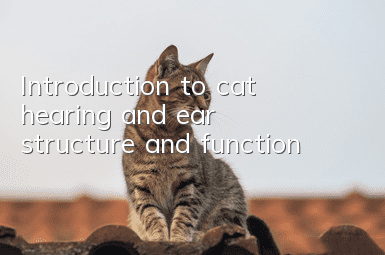Introduction to cat hearing and ear structure and function

Cat ears are located on both sides of the head. The outer ear is identified by the upright or visible part of the ear, called the pinna. A cat's auricles are located above and behind the eyes, in front of the head.
Cat ears are divided into three parts:
1. The external ear is composed of the protruding pinna (also called the auricle) and the external auditory canal (also called the auditory canal or ear canal). The auricle is a funnel-shaped structure that collects sound and directs it into the external auditory canal. The auricle is covered by skin, especially the outer or back sides, by hair. Attached to the curved cartilage between the inner and outer layers of skin around the auricle are numerous muscles that cause the auricle to move and twitch. The external auditory canal extends from the base of the auricle downward and inward to the eardrum (also called the tympanic membrane). The external auditory canal is L-shaped and lies on its side. The ear canal forms an almost 90-degree angle between its two parts, the short, vertical outer part and the long, horizontal inner part.
2. The middle ear includes the tympanic membrane and the bony tympanic cavity (osseous bulla), which is located behind the tympanic membrane. Within this eardrum cavity are found the ossicles, three small bones that vibrate when stimulated by sound waves. These ossicles are named the malleus, stirrup, and incus (often referred to as hammers, stirrups, and anvils) because of their resemblance to these objects. These three bones form a chain in the middle ear, from the eardrum to the oval window in the inner ear. The middle ear is connected to the back of the throat via the Eustachian tube. This tube allows air from the pharynx to move in and out of the middle ear, which helps keep middle ear pressure normal. The middle ear is connected to the inner ear through an oval window against the stapes.
3. The inner ear is located in the temporal bone of the skull and consists of two parts. The bony labyrinth is made up of a series of fluid-filled membranes called a labyrinth. The inner ear has three distinct structures: the cochlea (spiral canal), the vestibule, and the three semicircular canals. The cochlea contains nerves that carry electrical impulses and is directly responsible for hearing. The vestibule and semicircular canals are responsible for maintaining balance, or equilibrium. These tissues are supplied by two branches of the eighth cranial nerve (the vestibulocochlear nerve), which carry electrical impulses related to sound and balance back to the brain.
What is the function of cat ears?
The two main functions of the ear are to detect and hear sounds, and to maintain balance.
Listening. Sound first enters the external auditory canal in the form of sound waves. When these sound waves hit the eardrum, it starts to vibrate. These vibrations are then transmitted to three small bones in the middle ear (the malleus, incus, and stapes), which amplify the sound vibrations. The end of the stapes is connected to the oval window of the inner ear. When the stapes vibrates, it transmits the vibrations of sound to the cochlea, a snail-shaped part of the inner ear, which converts the vibrations into nerve signals that are then passed to the brain, where they are interpreted as sounds.
Balance. Another function of the ears is to help maintain balance. The three semicircular canals of the inner ear are at right angles to each other. When the head rotates, theThe movement of this resulting fluid through these tubes allows the brain to detect the direction and magnitude of head rotation. Another part of the inner ear responds to gravity, sending messages to the brain when the head is held still.
Cat’s postnatal hearing development
Kittens’ hearing is not fully developed at birth. The external auditory canal only begins to open between 6 and 14 days (average 9 days), and does not fully open until the 17th day. Then the auricle deepens and widens until it reaches maturity at 31 days. At 2-3 days old, the earliest evoked potentials of the auditory system can be recorded electronically. The first sounds heard by kittens are 100 decibels and a frequency of 500-2000 cycles/second (cps). By day 6, the range expands to 200 to 6000cps. The auditory startle response to sharp noises usually appears by day 7. On the 7th day, the ears are able to localize sounds. In the 3rd or 4th week, they can recognize the sounds of nest mates or humans and coordinate with the conditioned defense response, that is, the arching-hissing response, which gradually stabilizes in the 5th week.
Auditory characteristics
Cats’ hearing abilities are not fully understood. It has been suggested that hearing is more important to cats than vision, which may be reasonable for nocturnal predators. The lower audible frequencies of cat hearing may be between 20 and 55 cps, and the high frequencies may be as high as 4000 cps. Cat hearing is roughly the same as that of humans, however the maximum sensitivity is between 250 and 35000 cps, even up to 20 dB or more. Low. The hearing limit is said to be about 78,000 cps at 60 dB sound pressure level, and the actual limit is probably closer to 100,000 cps. The use of different instruments has shown that sounds at these frequencies are capable of detecting cochlear activity, but whether cats can actually hear these sounds remains unknown.
Acute hearing may be important to cats because the frequency of social interactions between female rodents and their pups ranges from 17,000 to 148,000 cps, often 80,000 cps or less. Inexperienced kittens will attack young rats if stimulated by the squeaking of a female rat, indicating that they can hear the sound and react instinctively. The human hearing range is approximately 20 to 19,000 cps. At the higher treble, cats can accurately hear pitch differences of 1/10 to 1/5. Cats can also tell the difference between four clicks per second and six clicks per second.
As cats age, they gradually lose their hearing ability, especially in the higher ranges.
Sound is received and transmitted
As nocturnal predators, cats must rely on hearing to locate prey. Sound localization and maximum receptionis the main function of the cupped auricle, especially at high frequencies. The position of your ears does change the perception of sound. The greatest interaural intensity differences are produced by sounds 20 to 40 degrees from the midfrontal line and at least 20,000 cps. This also happens with peripheral lower sounds. Since the pinna can rotate about 180 degrees, it may introduce or at least amplify complex sound quality changes related to the sound source, which is an important factor in sound localization. Unless the sound is coming from directly in front or behind, each ear hears it for a slightly different time, ranging from 25 to 80 microseconds, which can help localize the sound. Within the ear, the tympanic bulla is large and therefore increases auditory resonance.
The cat's cochlea differs from humans in length, cell density, and absolute threshold. It is approximately two-thirds the length of the human cochlea and can respond to a wider range of sounds. Although there are only 12,300 hair cells in a cat's cochlea compared to 23,500 in humans, they are connected to many more ganglion cells. From the ganglion cells, approximately 40,000 cochlear nerve fibers carry impulses to the brain, which is 10,000 more than in humans. Each nerve fiber has a "best" frequency at which it is at its lowest threshold.
For a tone, 68% of the units are either excited or inhibited. The rest respond only during onset. These sound impulses travel through a clear neural pathway to the auditory cortex, where they are analyzed.
Sound localization is related to the superior colliculus. This allows it to coordinate eye, ear, and head direction in response to visual, auditory, and somatosensory stimuli. The organization of frequencies entering the auditory cortex cannot be modulated. Although auditory fibers are the only sensory fibers that are fully myelinated at birth, the auditory system continues to mature, as evidenced by reduced peak latencies of cortical evoked potentials until reaching a minimum interval of about 1 ms in adults. The central nervous system develops faster than vision. Studies of conscious cats suggest that other areas of the brain may also be involved in electrical potentials from sounds, particularly areas near the auditory cortex. In addition to the movable pinna, auditory neurons also play an important role in sound localization. The accuracy of sound localization is 75%, which is only 2 degrees lower than humans.
However, this ability of cats decreases at lower and higher frequencies. Some neurons respond to contralateral stimulation but are inhibited by binaural same-frequency stimulation, occurring in direct projections from the cochlear nucleus to the contralateral trapezoidal nucleus and then to the lateral superior olive area. Other neurons can respond to differences in stimulation between the ears. Others may be affected by differences in stimulus intensity on both sides. Almost all respond more readily to changes in frequency from high to low than in other directions. This is consistent with the natural tendency to vocalize. Although amplitude and frequency discrimination abilities are typically affected to varying degrees in adults, this process affects sound localization most severely.
Certain drugs, especially aminoglycosides, can also cause hearing loss in cats.decline. Kanamycin affects the hair cells at the base of the cochlea, causing loss of high-frequency sensation, while neomycin can impair the auditory function of the eighth cranial nerve. Long-term use of streptomycin may also cause deafness.
After reading this, you should have a deeper understanding of cats’ ears and hearing. So, do you understand how to examine and diagnose cat ear canal diseases and hearing impairment?
- How do you teach a newly purchased cat to use cat litter?
- Why do cats have a cloudy film on their eyes?
- Can a six month old cat get pregnant?
- What should I do if my cat eats some green onions?
- Is it good for cats to drink yogurt?
- Can novel coronavirus pneumonia be transmitted to cats?
- Do cats need to be quarantined if there is cat-to-cat transmission?
- Cat’s belly is big and soft
- Can Siamese cats eat bananas?
- Can a two-month-old cat eat canned food?



